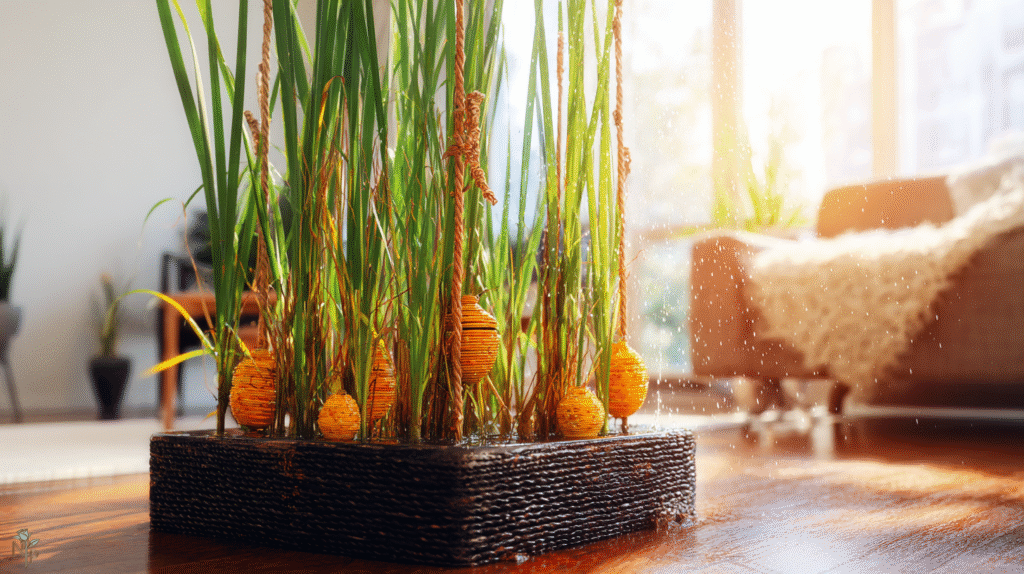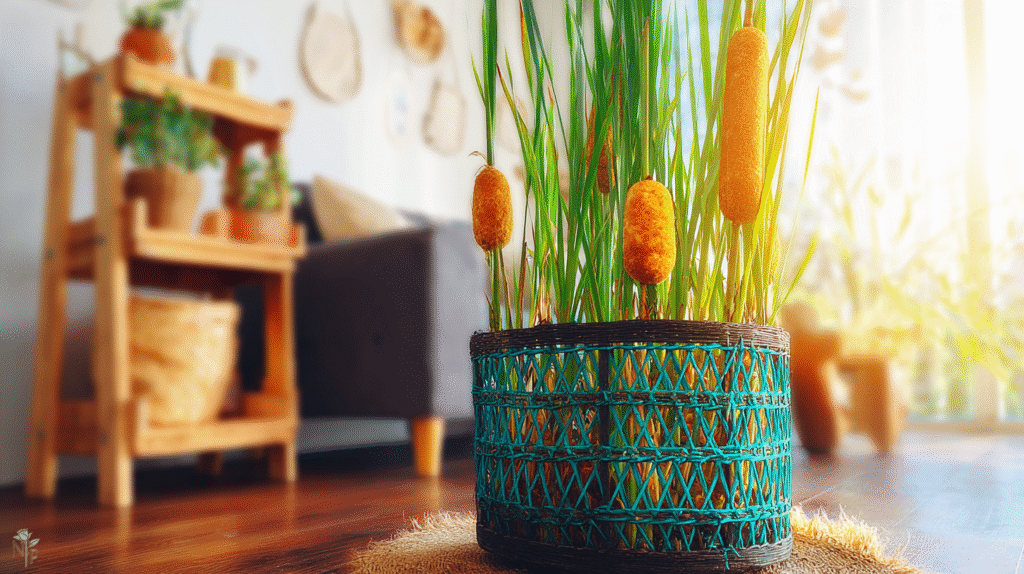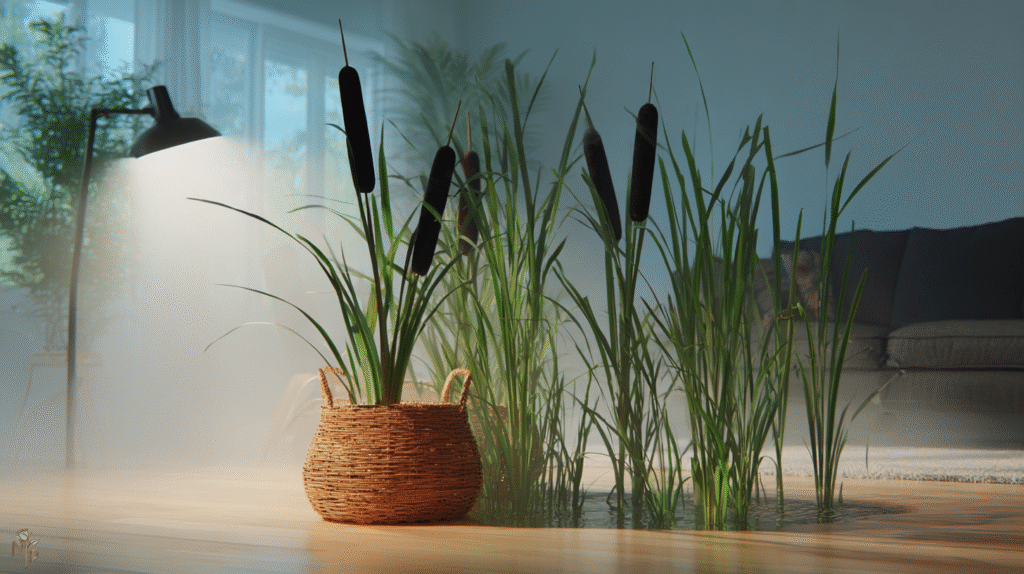So I bought a cat tail plant because the nursery lady said it was “super easy” and would look amazing in my living room. Three weeks later, I’m watching it turn brown and crispy while frantically googling “why is my cat tail plant dying” at 2 AM.
Turns out “super easy” means different things to different people. To her, it meant “easy if you recreate a literal swamp in your house.” To me, it meant “water it sometimes and hope for the best.” We were not on the same page.
After killing that first one (RIP), then a second one (overcompensated with too much water), I finally cracked the code. These plants aren’t house plants trying to survive indoors – they’re pond plants pretending to be houseplants. Once I stopped treating mine like a pothos and started treating it like the swamp creature it actually is, everything changed.
Now I’ve got three cat tail plants that are so happy they’re trying to take over my apartment. One’s taller than my boyfriend. Another one actually bloomed indoors, which apparently isn’t supposed to happen. Here’s what nobody tells you about keeping these drama queens alive.
The Big Fat Lie About Cat Tail Plants
Every care guide online: “Great for beginners! Tolerates various conditions!”
What they should say: “Great for beginners who own a greenhouse with a pond.”
Cat tail plants (the fancy name is Typha, but nobody uses that) are basically marsh plants. In the wild, they grow with their feet in water, in full sun, in actual mud. Your living room with its dry air and mood lighting? Not even close.
The breakthrough came when I stopped asking “how do I grow this indoors?” and started asking “how do I make indoors feel like a swamp?” Sounds gross, but it worked.

Water: More Than You Think Is Humanly Possible
Remember how I said I killed my second one with too much water? Yeah, I was wrong. It wasn’t too much water – it was the wrong KIND of watering.
Cat tails don’t want to be watered. They want to be IN water. Like, standing in it. All the time. This blew my mind because everything I knew about plants said standing water = root rot = death.
What actually works: I keep mine in cache pots (decorative pots without holes) with 2-3 inches of water at the bottom. Always. The regular pot sits in this water bath like it’s at a spa.
First time I tried this, I was convinced I’d wake up to root rot. Instead, I woke up to new growth. Four new shoots in a week. The thing went from dying to thriving literally overnight.
In summer, I’m adding water every 2-3 days because these things drink like they’re headed to plant AA. Winter slows down to weekly, but there’s ALWAYS water in that cache pot.
The distilled water discovery: My tap water is harder than my attempts at yoga. All that chlorine and minerals were building up and burning the leaf tips. Switched to distilled water (annoying but worth it) and the brown tips stopped.
Pro tip: I buy those huge jugs of distilled water from the grocery store. $1 each, lasts about a week per plant. Cheaper than watching $30 plants die.
Light: The Plot Twist Nobody Mentions
Everyone says cat tails need “full sun.” Cool. So I put mine in my sunniest south window. It got sadder. Moved it to the bathroom with a frosted east window. Even worse. Was about to give up when my neighbor mentioned she grows hers under a grow light.
Game. Changer.
Turns out “full sun” outdoors and “full sun” indoors are completely different beasts. Outdoor full sun is like 10,000+ foot candles of light. My “sunny” window? Maybe 2,000 on a good day. No wonder it was struggling.
Bought a $30 LED grow light from Amazon (the purple one that makes my living room look like a disco). Keep it on 12 hours a day. My cat tail went from barely surviving to growing so fast I can literally see daily progress.
The sweet spot I found:
- Morning direct sun through east window: good
- Grow light 12 hours a day: better
- Both together: cat tail paradise
Without enough light, they get leggy and sad. The leaves flop over instead of standing upright. With proper light, they’re stiff and proud, like they’re showing off.
Humidity: The Secret Sauce
My apartment in winter has the humidity of the Sahara. The heater runs constantly, sucking every molecule of moisture from the air. My skin hates it. My cat tail plants REALLY hate it.
First winter, I watched my beautiful 4-foot cat tail develop brown edges on every single leaf. Tried misting (useless). Tried a pebble tray (slightly less useless). Finally bought a humidifier.
Not one of those tiny desktop ones – a proper 6-liter beast that runs all day. Humidity went from 25% to 55%. Cat tails went from crispy to glossy. Even my skin improved, so win-win.
The bathroom experiment:
My friend keeps hers in the bathroom with a skylight. The humidity from showers keeps it happy without a humidifier. Tried it, but my bathroom has no windows. Cat tail in the dark = very sad plant. Back to the living room humidifier setup.
Container Crisis: Bigger Isn’t Always Better
Made the classic mistake of putting my cat tail in a massive pot thinking it needed room to spread. What actually happened? The soil stayed too wet (even for a swamp plant), got funky, and the roots rotted.
Cat tails grow from rhizomes (basically underwater roots that spread horizontal). They want to spread OUT, not DOWN. A wide, shallow container works way better than a deep one.
My current setup:
- 12-inch wide, 8-inch deep plastic pot (with holes)
- Sitting in a 14-inch decorative cache pot (no holes)
- 2-3 inches of water in the cache pot always
- Rocks in the bottom of the cache pot to keep the inner pot elevated slightly
Looks like a lot of work written out, but it’s literally just a pot in a pot with some water. Takes 30 seconds to set up.
Soil That Makes No Sense But Works
Regular potting soil = death sentence. Learned this the expensive way.
Cat tails want heavy, water-retaining soil. The opposite of what every other houseplant wants. I use:
- 50% cheap topsoil (the dense stuff)
- 25% peat moss (holds water like crazy)
- 25% sand (for weight)
It’s basically mud. When I water from the top (rarely), it doesn’t drain. It just sits there. For any other plant, this would be murder. For cat tails, it’s perfect.
Some people grow them in pure clay. I tried it with modeling clay from the craft store mixed with sand. Worked great until repotting time – had to literally chisel the plant out. Back to my mud mixture.

Temperature Tantrums
Thought these were tropical plants that wanted warmth. Nope. They’re from temperate zones and actually prefer it cooler. My apartment at 72°F in winter made them struggle. Dropped it to 65°F (I wear sweaters now) and they perked right up.
In summer, they can handle heat fine AS LONG AS their feet are wet. Let them dry out in heat and they’ll throw a dramatic death scene that would win an Oscar.
The Feeding Schedule That Sounds Insane
These things are HUNGRY. Like, teenage boy hungry. I fertilize every two weeks in growing season with regular liquid fertilizer at full strength. Any other plant would burn. Cat tails ask for seconds.
Winter I drop to monthly, but they still get fed. Stopped feeding one winter and it got so pathetic looking I thought it was dying. Started feeding again, bounced back in a week.
Mistakes That Still Make Me Cringe
The terrarium disaster: Tried to be cute and plant a small cat tail in a terrarium. No drainage, high humidity, seemed perfect. It rotted in a week. Turns out they need air movement too. Stagnant humid air = fungus city.
The outdoor adventure: Put one outside in summer thinking it would love “real” conditions. Forgot to bring it in one night. Raccoons destroyed it. Just… destroyed it. Found it floating in pieces in the water tray.
The cat situation: These are called cat tails but cats should NOT eat them. Mine did. Projectile vomiting ensued. Plant now lives on a shelf so high I need a ladder.
Why Bother With This High-Maintenance Nonsense?
Because when you nail the environment, these things are spectacular. My biggest one is 6 feet tall with leaves that rustle when the air moves. It’s like having a piece of wetlands in my living room.
Plus, they’re absolute units at air purifying. NASA didn’t study them (they were too busy with snake plants), but I swear the air in my living room is different since these moved in.
And honestly? Once you get the setup right – water reservoir, grow light, humidifier – they’re actually LOW maintenance. I spend maybe 5 minutes a week on all three combined. Just adding water and the occasional fertilizer. That’s it.

The Bottom Line
Cat tail plants aren’t houseplants. They’re pond plants on house arrest. Treat them like the swamp creatures they are and they’ll thrive. Try to treat them like a normal houseplant and they’ll die dramatically and make you feel bad about it.
My setup sounds complicated but it’s really just: pot in water, bright light, humid air, feed often. Once I stopped fighting their nature and started embracing it, they became the easiest plants I own. Way easier than my fussy fiddle leaf fig that drops leaves if I look at it wrong.






